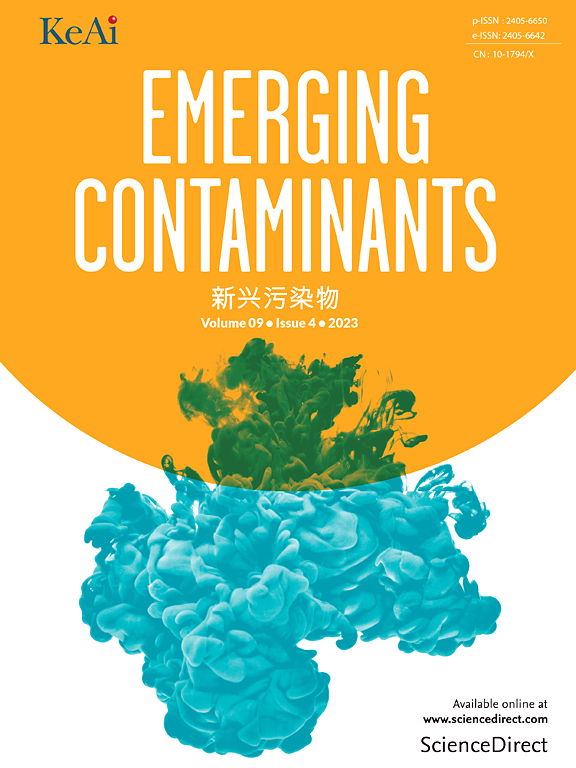Investigating contaminants of emerging concern (CECs) in the Venice Lagoon: A suspect screening approach for the analysis of water and sediment contamination
IF 6.9
2区 环境科学与生态学
Q1 ENVIRONMENTAL SCIENCES
引用次数: 0
Abstract
The presence of Contaminants of Emerging Concern (CECs) in the environment poses significant concern, yet their occurrence, sources, and fate remain not fully understood. This study provides the first investigation of a broad range of CECs, including active pharmaceutical ingredients (APIs), plant protection products (PPPs), and personal care products (PCPs), across raw and treated wastewater, surface water, and sediment in the Venice Lagoon and selected tributaries. Using a suspect screening analysis methodology based on high-resolution mass spectrometry (HRMS), 14 sampling stations were selected to identify contamination patterns and potential emission sources. APIs were the most frequently detected class of compounds (150 compounds), with flecainide, harman, carbamazepine, and venlafaxine found in more than 80 % of sampling stations. Analgesics were the dominant therapeutic class, followed by antidepressants and cardiovascular drugs. Among PCPs (17 compounds), icaridin, and climbazole were the most prevalent, detected at 11 and 9 sampling stations, respectively. PPPs (26 compounds) were also detected, with diuron being the most widespread as it was found at 10 sampling stations. To the best of the authors' knowledge, 92 compounds (68 APIs, 17 PCPs, and 7 PPPs) were qualitatively identified for the first time in the Venice Lagoon, although many of them are known to occur in natural waters worldwide.
The results highlight rivers and treated wastewater as major contributors to CEC emissions in the lagoon. These findings offer valuable insights for future research and targeted monitoring strategies, advancing the understanding of unmonitored contaminants in vulnerable aquatic environments.
调查威尼斯泻湖新出现的污染物(CECs):水和沉积物污染分析的可疑筛选方法
环境中新兴关注污染物(CECs)的存在引起了人们的极大关注,但它们的发生、来源和命运仍未完全了解。本研究首次对威尼斯泻湖和部分支流的原水和处理过的废水、地表水和沉积物进行了广泛的CECs调查,包括活性药物成分(api)、植物保护产品(PPPs)和个人护理产品(pcp)。采用基于高分辨率质谱(HRMS)的可疑筛选分析方法,选择了14个采样站来确定污染模式和潜在的排放源。原料药是最常检测到的一类化合物(150种化合物),在80%以上的采样站中发现了氟氯胺、哈曼、卡马西平和文拉法辛。镇痛药是主要的治疗类别,其次是抗抑郁药和心血管药物。在17种pcp化合物中,以鸢尾素和克里巴唑最常见,分别在11个和9个采样点检测到。还检测到PPPs(26种化合物),其中diuron分布最广,在10个采样站均有发现。据作者所知,在威尼斯泻湖中首次定性鉴定了92种化合物(68种原料药,17种pcp和7种PPPs),尽管其中许多已知存在于全球自然水域。结果表明,河流和处理过的废水是泻湖中CEC排放的主要来源。这些发现为未来的研究和有针对性的监测策略提供了有价值的见解,促进了对脆弱水生环境中未监测污染物的理解。
本文章由计算机程序翻译,如有差异,请以英文原文为准。
求助全文
约1分钟内获得全文
求助全文
来源期刊

Emerging Contaminants
Medicine-Public Health, Environmental and Occupational Health
CiteScore
10.00
自引率
6.70%
发文量
35
审稿时长
44 days
期刊介绍:
Emerging Contaminants is an outlet for world-leading research addressing problems associated with environmental contamination caused by emerging contaminants and their solutions. Emerging contaminants are defined as chemicals that are not currently (or have been only recently) regulated and about which there exist concerns regarding their impact on human or ecological health. Examples of emerging contaminants include disinfection by-products, pharmaceutical and personal care products, persistent organic chemicals, and mercury etc. as well as their degradation products. We encourage papers addressing science that facilitates greater understanding of the nature, extent, and impacts of the presence of emerging contaminants in the environment; technology that exploits original principles to reduce and control their environmental presence; as well as the development, implementation and efficacy of national and international policies to protect human health and the environment from emerging contaminants.
 求助内容:
求助内容: 应助结果提醒方式:
应助结果提醒方式:


